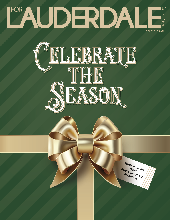
Our most infamous adjoining hamlet featured just 14 mobile homes, an orange grove, some junkyards and a couple of bars.
It had 133 residents and 18 police officers. The purpose? To tag speeders on a five-mile stretch of State Road 84 — and dole out huge fines. Tickets were so numerous, there was a night court to process citations. That was Hacienda Village.
Mayor Sherman “Red” Crise, who settled here in 1964, was the genius behind the ticketing enterprise, which relieved the city of having to tax its residents. He also appointed himself police chief, fire chief and judge magistrate. Red could be spotted roaming city streets in his red 1968 Cadillac Eldorado, which he used as a police car.
The larger bar, the Hacienda Inn, featured country bands and stayed open until 4 a.m. The hours were no problem for Red – he was owner and proprietor. There was also the El Toro Pub, a dive bar frequented by a biker gang, The Outlaws.
And it seemed no one could stop the iffy ticketing enterprise until they pulled over a state legislator in a speed trap. He vowed to nullify Hacienda Village’s incorporation in Tallahassee. He lost the first battle but other legislators jumped into the fray. Finally a new highway – I-595 – gutted the town. In 1984, Davie annexed Hacienda Village and the shenanigans ended.
Other incorporated areas that sprung up around Fort Lauderdale provide some little-known turns in their stories. (Not included here are Pompano Beach, Hollywood, Dania Beach, etc., because they existed even before we were incorporated.)
Plantation, as we have noted before, was never a plantation. True, early plans called for a rice plantation on land held by the Everglades Plantation Company. Delays in government drainage promises – the area was once covered by two to three feet of water and only hospitable to the Seminoles – scuttled that idea.
Later plans called for a community of 200 two-bedroom homes, each with an acre of land and 20-tree fruit orchards. But after construction began, along came 93 consecutive days of rain and two hurricanes. Plantation was incorporated with a different look in 1953.
Davie, the town that annexed Hacienda Village, was originally called Zona. Strange, I thought, when I first uncovered this some 10 years ago. Zona?
Yes indeed. It was Spanish for zone, and rightfully so: The first settlers were a group of families who bought acreage in the swampy area and were well acquainted with digging the earth. They all worked on the Panama Canal dig, where they heard of the cheap land being offered in what is now Davie. They bestowed the early moniker.
Wilton Manors has an ironic origin story, seeing how the town has evolved. You would never know it was first incorporated as a hamlet for seniors.
Miramar began when a South Broward dairy farmer named Henry Perry was approached to sell his square mile of land by a northern businessman with money to burn. The Northerner made his fortune selling Persona Razor Blades, and he had plans for a major housing development. Perry agreed, but only if he could manage the new construction himself. A deal was made, and the area was later incorporated in 1955, becoming the largest city by land size in Broward County today.
The incorporation of Margate came four days after that of Miramar, on 1,900 acres west of Pompano. In those days, even the Rockefellers were getting into the South Florida real estate act. Part of this parcel was scooped up by Winthrop Rockefeller, fourth son of John D. Rockefeller.
If Hacienda Village was one of our most colorful surrounding towns and Miramar is our largest by land size, Lazy Lake is the tiniest.
The 1946 subdivision circling a lake was incorporated in 1954 so it wouldn’t be annexed by Wilton Manors. For 30 years, residents say, the community (numbering under 50) was crime-free. Then the first major crime was recorded: A villager illegally put four swans in the lake. Horrors!
For a two-year period closer to our time, Lazy Lake was up for sale. News reports said that both O. J. Simpson and a Kuwaiti prince were interested. When they and others could not come to a deal, the For Sale sign came down.
This survey is not complete, as other towns that popped up in Broward, like Lighthouse Point, have their colorful stories (see Club Unique, i.e. Cap’s Place and patrons FDR and Winston Churchill, for example). But let this be an impetus for inquiring minds to delve further.









